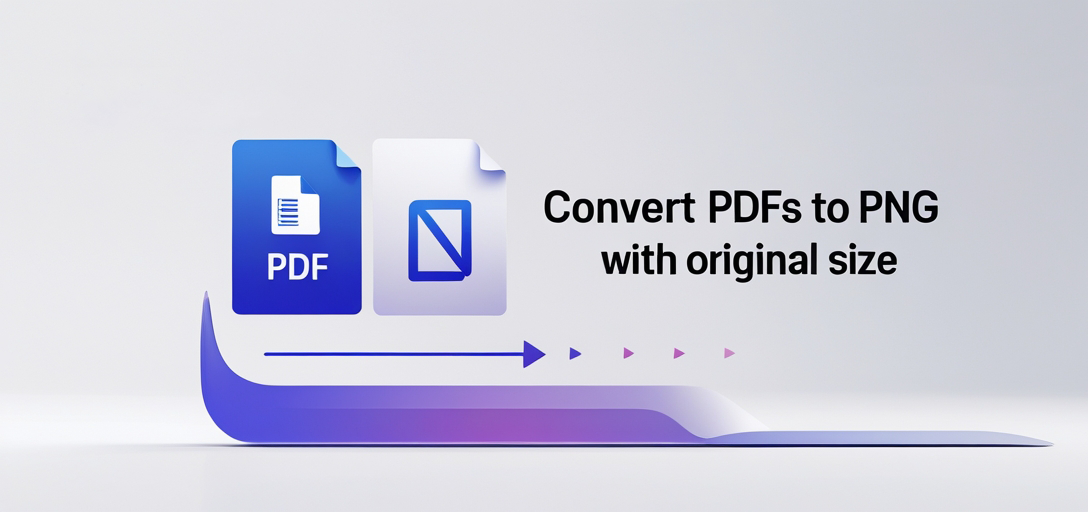Convert PDFs to PNG with Original Size Using GroupDocs.Viewer for .NET
Introduction
Converting PDF files into PNG images while maintaining the original page size is essential for high-quality document digitization or web content preparation. This tutorial will guide you through using GroupDocs.Viewer for .NET to render PDF pages as PNG files, preserving their original dimensions.

What You’ll Learn:
- How to set up and configure GroupDocs.Viewer for .NET in your project
- Step-by-step process of rendering PDFs to PNG images while maintaining page sizes
- Key configuration options and best practices for optimal performance
By the end of this tutorial, you’ll be able to integrate this functionality into your applications seamlessly. Let’s begin with the prerequisites necessary to get started.
Prerequisites
Before implementing GroupDocs.Viewer for .NET in your project, ensure that you have the following requirements:
Required Libraries and Versions
- GroupDocs.Viewer for .NET: Version 25.3.0 or later.
Environment Setup Requirements
- A compatible development environment such as Visual Studio.
- Basic understanding of C# programming.
Knowledge Prerequisites
- Familiarity with NuGet package management.
- Some experience working with PDFs and image processing in .NET applications.
Once you have these prerequisites in place, we can proceed to set up GroupDocs.Viewer for .NET.
Setting Up GroupDocs.Viewer for .NET
To start using GroupDocs.Viewer for .NET, follow the installation steps below:
Installation via NuGet Package Manager Console
Open your project in Visual Studio and use the following command:
Install-Package GroupDocs.Viewer -Version 25.3.0
Installation via .NET CLI
Alternatively, you can install it using the .NET CLI with this command:
dotnet add package GroupDocs.Viewer --version 25.3.0
License Acquisition Steps
- Free Trial: Download a trial version from GroupDocs Downloads.
- Temporary License: Obtain a temporary license to explore full features at Temporary License Page.
- Purchase: For extended use, purchase a license through the Buy Page.
Basic Initialization and Setup
To initialize GroupDocs.Viewer for .NET in your C# project, follow these steps:
- Import necessary namespaces:
using System; using GroupDocs.Viewer; using GroupDocs.Viewer.Options; - Set up the paths for your input PDF and output directory.
- Initialize
Viewerwith the path to your source document, as shown in this snippet:string documentPath = "YOUR_DOCUMENT_DIRECTORY/SAMPLE_PDF.pdf"; string outputDirectory = "YOUR_OUTPUT_DIRECTORY"; string pageFilePathFormat = $"{outputDirectory}/page_{0}.png"; using (Viewer viewer = new Viewer(documentPath)) { PngViewOptions viewOptions = new PngViewOptions(pageFilePathFormat); viewer.View(viewOptions); }
Implementation Guide
This section covers the implementation of rendering PDF pages as PNG images while maintaining their original size.
Rendering PDF Pages to PNG with Original Page Size
Overview
This feature allows you to render each page of a PDF document into a PNG image, preserving its original dimensions. This is particularly useful for applications requiring precise visual representation of documents.
Step 1: Setup Paths and Initialize Viewer
Create variables for your input PDF path and output directory:
string documentPath = "YOUR_DOCUMENT_DIRECTORY/SAMPLE_PDF.pdf";
string outputDirectory = "YOUR_OUTPUT_DIRECTORY";
string pageFilePathFormat = $"{outputDirectory}/page_{0}.png";
Initialize the Viewer class with your source document path:
using (Viewer viewer = new Viewer(documentPath))
{
// Code block will continue in the next step
}
Step 2: Configure PngViewOptions
Create an instance of PngViewOptions, specifying a file naming pattern for the output images:
PngViewOptions viewOptions = new PngViewOptions(pageFilePathFormat);
Configure the viewer options to render each page at its original size:
viewOptions.PdfOptions.RenderOriginalPageSize = true;
Step 3: Render Document Pages
Call the View method on your Viewer instance, passing in the configured view options:
viewer.View(viewOptions);
Troubleshooting Tips
- Ensure paths are correct and directories exist.
- Verify that you have the necessary permissions to read from input and write to output directories.
Practical Applications
- Document Digitization: Convert archival PDF documents into digital images for easier access and distribution.
- Web Portals: Display document previews on websites without requiring PDF readers.
- Content Management Systems (CMS): Integrate with CMS platforms to manage and display large volumes of PDF content efficiently.
Performance Considerations
To optimize the performance of your application using GroupDocs.Viewer for .NET:
- Limit memory usage by processing documents in chunks if dealing with large files.
- Use asynchronous methods where possible to avoid blocking threads during rendering.
- Dispose of
Viewerinstances promptly after use to free up resources.
Conclusion
In this tutorial, you’ve learned how to render PDF pages as PNG images while maintaining their original sizes using GroupDocs.Viewer for .NET. We covered setting up your environment, configuring the necessary options for optimal results, and explored practical applications for this functionality.
Next steps include experimenting with other rendering options available in GroupDocs.Viewer or integrating it into larger projects for enhanced document management capabilities.
FAQ Section
- What is the best way to handle large PDF files with GroupDocs.Viewer?
- Process documents in smaller chunks and use asynchronous methods to maintain performance.
- Can I customize the output PNG file names?
- Yes, by specifying a naming pattern in
PngViewOptions.
- Yes, by specifying a naming pattern in
- Is it possible to render specific pages only?
- Absolutely, you can configure
PageNumbersinPngViewOptionsto specify which pages to render.
- Absolutely, you can configure
- How do I handle licensing for GroupDocs.Viewer?
- Options include a free trial, temporary license, or purchasing a full license.
- Can this setup be used in web applications?
- Yes, it’s suitable for server-side rendering of PDFs in ASP.NET Core and other .NET-based web frameworks.